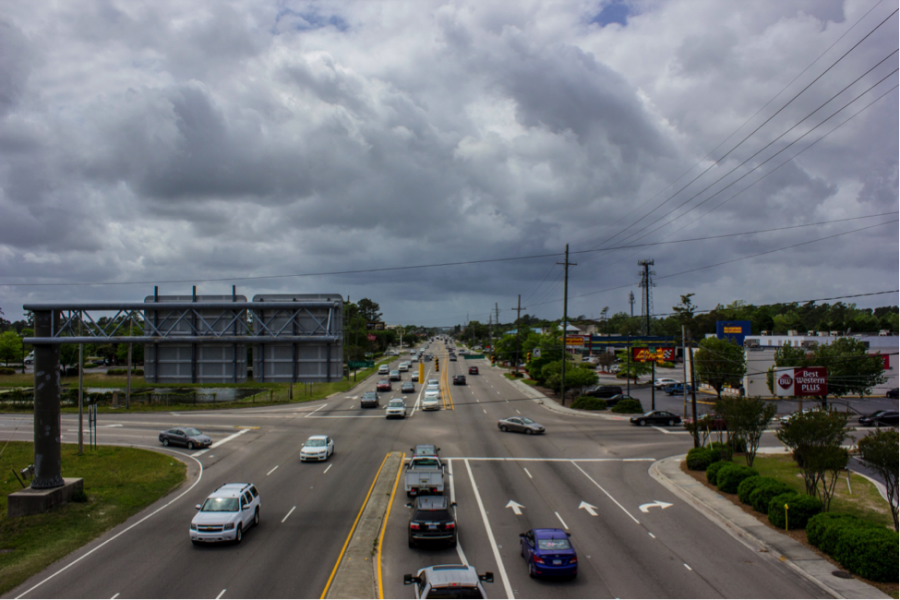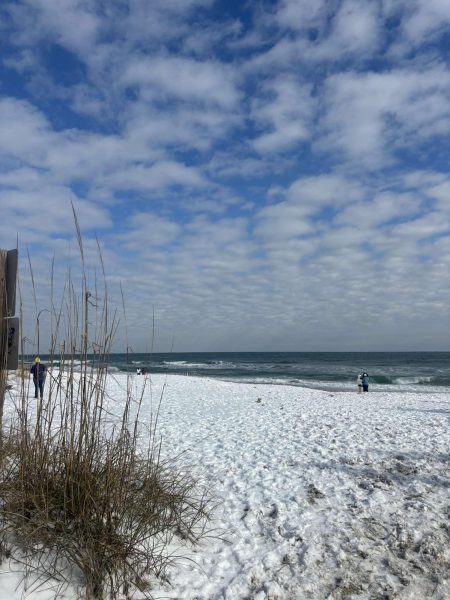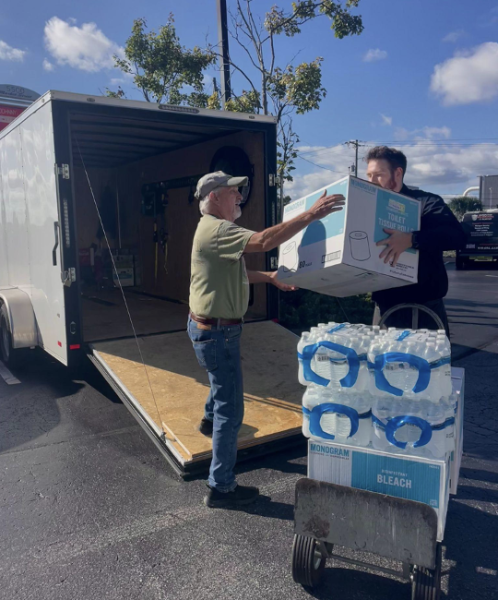Plans for coping with Wilmington’s growing traffic concern
Multiple cars line the middle turn lane of South College Road in Wilmington. Vehicles, trucks, buses and motorbikes whiz past on the right, occasionally halting for a distant traffic signal. For minutes, the turning drivers fight the onslaught of oncoming traffic to make a simple left turn into the parking lot of a local restaurant, Carolina BBQ.
Restaurant employees and patrons alike watch the traffic accumulate from just outside the window. When rush hour comes to Wilmington, so does the frustration.
For many drivers in the region, heavy traffic is all they are used to. College Road, Market Street, Oleander Drive, Carolina Beach Road, you name it, it is congested. The only relief time for some seems to be at the extreme late hours of night or early morning.
It is a trend that has not only persisted, but it has continually gotten worse as the years have progressed. This issue leaves many Cape Fear area residents wondering why, or better yet, wondering what can be done about the growing traffic concerns.
According to the U.S. Census, between 2000 and 2016, the population of New Hanover County has soared from 160,000 to near 223,000. This explosion of population growth, coupled with the lack of rapid updates to infrastructure, has led to traffic snarls at major intersections across the area for the past several years.
The headaches caused by the increasingly crowded commutes have prompted many Wilmington residents to try and make their voices heard to local authorities.
At the Wilmington Metropolitan Planning Organization, future traffic plans, projects and statistics are all coordinated within the department regarding Wilmington and surrounding areas. According to the Wilmington MPO, the most congested section of roadway in the city belongs to South College Road.
“The busiest segment that I have on file within the Wilmington city limits is South College Road between Fountain [Drive] and Wilshire [Boulevard]. The average daily volume for this location is 69,854 vehicles,” said Greg Laughter, Traffic Counter for the City of Wilmington.
For reference, Fountain Drive is located just south of UNC Wilmington campus, across from the Cook Out restaurant. Wilshire Boulevard is just down the road, adjacent to a McDonald’s, Harris Teeter and the Stevenson Honda of Wilmington dealership.
However, “there are a number of factors that can influence busyness of a roadway,” said Don Bennett, City Traffic Engineer for the City of Wilmington. “Busy-ness is a qualitative measure rather than a quantitative. Roadways are quantitatively measured by Volume to Capacity ratios and associated delay values.”
Bennett went on to say that many residents who come to Wilmington from cities such as Boston, Washington, Los Angeles and New York say that the traffic here is minimal. Whereas for a local resident who commutes during rush hour every morning and evening, the traffic may be viewed as awful.
Another factor is how many lanes a road may have, a major difference between wide thoroughfares such as South College Road and two-lane streets like Racine Drive.
Traffic signal spacing can also cause a heavy amount of stop and go congestion, such as if two signals were within 1000 feet of each other, cars could get backed up through both signals.
Finally, friction can play a part in the overall congestion of a roadway. Essentially, “friction” refers to the interference of driveways and streets channeling into the main road.
“Look at Randall [Parkway] between South College Road and Independence [Boulevard], while the volumes are relatively the same, from College to Kerr [Avenue] appears more busy than from Kerr to Independence. There’s much more friction caused by driveways and streets between College and Kerr,” Bennett said.
In addition to South College Road seeing the highest traffic volumes in Wilmington, it also has a major intersection with Oleander Drive, which has suffered from congestion problems for years.
“According to information available on our Average Annual Daily Traffic maps as of 2015, that number is approximately 75,000 vehicles per day that go through that intersection,” said Stonewall Mathis, Deputy Division Traffic Engineer for Division 3 of the North Carolina Department of Transportation.
During peak hours, both arterials can see backups at the intersection for a few blocks in each direction. As a result, the junction has become a hotspot for exasperated drivers in the city.
During rush hour, it can take up to ten minutes to travel half a mile on South College Road between the Shipyard Boulevard intersection and the Oleander Drive signal.
The traffic backups have affected local businesses along both roads as well, one of which is Carolina BBQ, located just south of the major intersection. The restaurant has no actual traffic signal, so drivers have been forced to sit in the turning lane at rush hour, or approach the restaurant from a side road, Spirea Drive.
“I don’t see what they [the City] could do to fix it,” said one employee of Carolina BBQ, Angie Torbush. The restaurant has been in Wilmington for over a decade now, and has witnessed the continual rise in traffic numbers.
“If you get out of that traffic, you can’t get back into that traffic because nobody’s gonna let you in,” she said. When asked if drivers may pursue restaurants on the other side of the road to avoid the turn lane, she said, “I would think so. I would, knowing it’s so hard to get across this traffic.”
She also mentioned the fact that many senior citizens drive up from southern New Hanover County to eat at the restaurant earlier in the day, just so they can avoid the traffic. But the economic impact on the growing congestion is becoming clearer and clearer to local business owners.
In the future, the NCDOT may pursue action to renovate and redesign the South College Road and Oleander Drive intersection, according to reports from the Wilmington Star News. However, no official project has been announced as of October 2017.
Meanwhile, the traffic problems in the region are not just focused on South College Road and Oleander Drive, they are spread out across the Cape Fear, including chokepoints on bridges and other arterials, and many proposed solutions have been floating around for years.
One possible solution involves a third crossing of the Cape Fear River from the junction of future Interstate 140 and U.S Highway 17 in Brunswick County to Independence Boulevard in southern New Hanover County.
The proposed third crossing has been dubbed the “Cape Fear Crossing” on the NCDOT’s project webpage and has a length of approximately 9.5 miles. The third crossing would help alleviate traffic on the Cape Fear Memorial Bridge and Isabel Holmes Bridge, currently the only two major crossings of the Cape Fear River into the city of Wilmington.
The problem with constructing the Cape Fear Crossing is the apparent lack of funds. The project itself is estimated to cost around $1 billion, and it is still in the Environmental & Design Studies phase. The right of way acquisition and construction phases both remain unfunded as of this time, but the Record of Decision is due in the summer of 2019, says the NCDOT.
Once funded, the Cape Fear Crossing should take five years to complete, according to estimates. But the project seems to have been on the minds of regional residents for several years.
The longstanding traffic problems have not just clogged up major roads in Wilmington, but in neighboring counties under the influence of the city as well.
In Pender County, U.S. Highway 17 is routed through Hampstead on its way to Jacksonville, and during late afternoon hours the highway can be backed up for a half mile or more at the stoplight with N.C. Highway 210.
Preparations for rerouting Highway 17 along a possible bypass of Hampstead have been discussed, along with the extension of Military Cutoff Road in New Hanover County to link up with the new bypass. Both projects are listed together as one on the NCDOT page as a project that is “In Development.”
Elsewhere, Brunswick County is preparing for the growing traffic issues across the region and plans have been made to prevent increased congestion throughout the county’s many towns.
Mike Hargett, the Director of Economic and Development Planning for Brunswick County said that the county’s transportation issues are unique in that the county itself belongs to three different transportation planning organizations.
“There have been ongoing improvements to U.S. Highway 74 to bring it closer to interstate standards, primarily in the form of installing interchanges at intersecting roadways,” Hargett said. “The Transportation Improvement Plan calls for continued improvements on U.S. Highway 17 regarding turning movements, for congestion management and safety.”
Brunswick County’s northeastern area, including the towns of Leland and Belville, is included in the Wilmington Metropolitan Planning Organization, whereas the southern area is included in the Grand Strand MPO, rolling over from the Myrtle Beach metro area.
“An interchange is planned on [U.S.] Highway 17 at the intersection with [N.C.] Highway 211, which will improve traffic flow, especially during the summer season,” Hargett said. He also noted that N.C. Highway 211 is scheduled for four-laning from Southport to Midway Road beginning in 2018 or early 2019, which also includes two new interchanges, one with Midway Road and another with Long Beach Road.
In regard to the completion of Wilmington’s new bypass, partially known as Interstate 140, Hargett said that it should be open to traffic by the end of the year and fully completed in 2018. The new bypass is expected to divert traffic around the city from Porters Neck at the New Hanover/Pender County line to U.S. Highway 17 in Brunswick County. The project’s completion has been long awaited by local residents.
With many ongoing and planned transportation projects throughout the Cape Fear and Wilmington metropolitan areas, residents of the region should pay attention to the traffic cones over the coming years. There will be many. With a population boom well underway, more upgraded infrastructure will be required to ease the inevitable throngs of vehicles crowding the roads around the city.
“With the [population] growth, I think it’s just gonna get worse.” Torbush said, as the traffic could be seen continuing to pile up outside of Carolina BBQ. “We really don’t have a lot of road frontage left now.”
Perhaps for Carolina BBQ, the transportation and roadway improvements on the horizon may bring them increased numbers of hungry drivers, looking for an escape from the increasingly crowded streets of the Port City.












